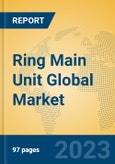Market Size and Growth Forecast
The global ring main unit market is projected to reach between USD 1.5 billion and USD 3.0 billion by 2025, with a compound annual growth rate (CAGR) of 3% to 8% through 2030, reflecting steady demand for reliable distribution solutions.Regional Analysis
North America: The U.S. leads with grid upgrades and renewable integration, while Canada focuses on rural electrification.Europe: Germany, France, and the UK dominate, driven by renewable energy transitions and smart grid initiatives.
Asia Pacific: China and India see rapid growth due to urbanization, while Japan emphasizes compact RMUs for urban grids.
Rest of the World: Brazil invests in distribution networks, and the Middle East, notably Saudi Arabia, supports smart grid projects.
Application Analysis
Distribution Utilities: Expected growth of 3.5-8.5%, driven by grid reliability needs. Trends focus on smart RMUs.Industrial Facilities: Projected growth of 3.0-7.5%, linked to industrial electrification. Developments emphasize durability.
Commercial and Residential Infrastructure: Anticipated growth of 2.5-7.0%, tied to urban expansion. Advances prioritize compact designs.
Renewable Energy and Micro-grids: Expected growth of 4.0-9.0%, driven by renewable integration. Trends highlight scalability.
Type Analysis
Gas-Insulated: Expected growth of 3.5-8.5%, valued for compact design. Trends focus on eco-friendly gases.Air-Insulated: Projected growth of 2.5-7.0%, appreciated for cost-effectiveness. Developments highlight reliability.
Oil-Insulated: Anticipated growth of 2.0-6.5%, used in specific applications. Advances focus on safety.
Solid/SF₆-Free Dielectric: Expected growth of 4.0-9.0%, driven by environmental regulations. Trends prioritize sustainability.
Key Market Players
Leading firms include Schneider Electric, offering smart RMUs; ABB, innovating in eco-friendly solutions; Siemens, focusing on grid reliability; Eaton, targeting industrial applications; CG Power & Industrial Solutions, expanding in emerging markets; LS Electric, advancing compact designs; Tiepco, providing customized solutions; Lucy Electric, enhancing urban grids; Orecco, supporting renewable integration; and Entec Electric & Electronics, focusing on micro-grids. These companies drive growth through innovation and global expansion.Porter's Five Forces Analysis
Threat of New Entrants: Low, due to high technical and regulatory barriers.Threat of Substitutes: Low, as RMUs are critical for medium-voltage distribution.
Bargaining Power of Buyers: Moderate, with utilities seeking cost-effective, reliable solutions.
Bargaining Power of Suppliers: Low, due to multiple component suppliers.
Competitive Rivalry: Moderate, with competition on sustainability and smart features.
Market Opportunities and Challenges
Opportunities: Over 30% of global electricity from renewables in 2024 drives RMU demand. Smart grid initiatives and micro-grid growth offer potential. Innovations like Schneider’s SF₆-free RMUs enhance sustainability, while emerging markets expand infrastructure.Challenges: High costs of advanced RMUs limit adoption in developing regions. Environmental regulations on SF₆ gas pose compliance hurdles. Limited technical expertise in some markets slows penetration.
This product will be delivered within 1-3 business days.
Table of Contents
Companies Mentioned
- Schneider Electric
- ABB
- Siemens
- Eaton
- CG power & industrial solutions
- LS Electric
- TiepcoLucy Electric
- Orecco
- Entec Electric & Electronics








